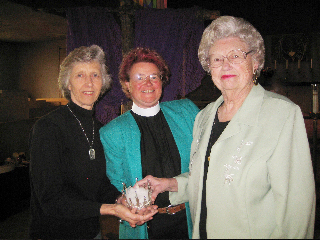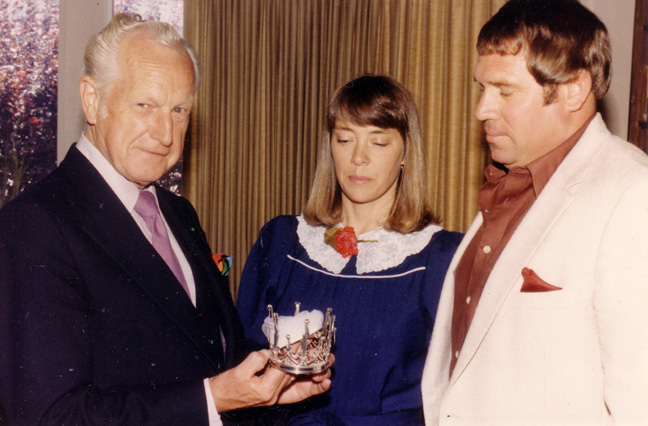Early Swedish wedding traditions
"Brudkronan," the Swedish wedding crown—in olden days a mandatory part of the bridal outfit in Sweden.
-
 Susan Bianucci, chair of the Library and Archives committee at the Swedish American Hall, Pastor Stacy Boorn of Ebenezer Lutheran Church and Jean Stohl Nelson, former member of the Board of Directors of the Swedish Lutheran Church.
Susan Bianucci, chair of the Library and Archives committee at the Swedish American Hall, Pastor Stacy Boorn of Ebenezer Lutheran Church and Jean Stohl Nelson, former member of the Board of Directors of the Swedish Lutheran Church. -
-
One of the ancient and revered cultural mementoes from early days in Sweden is the Bridal Wedding Crown worn for the marriage ceremony. In olden days, some sort of special head decoration was usually part of the bridal outfit. An early version is perhaps illustrated by a maiden’s ringlet which consisted of a wreath with ribbons down the back. Another version might have been a circular headdress or tiara with colorful ribbons, streamers and myrtle leaves. Eventually, a bridal crown (“brudkrona”) was fashioned out of metals such as brass, gold or silver which may also have had some wreathes of myrtle. The diameter of the base of a typical crown was about 2 inches and flaring out to 3¼ inches and about 3¼ inches tall. The crown was perched on the bride’s head on top of the veil. A church requirement for wearing the crown was that the bride must be a virgin.
Swedish artist Jufwas Anders Ersson (1757-1834) injected a bit of humor into one of his paintings. The painting had five foolish brides and five wise ones. Crowns were tilted on the heads of the foolish ones and straight on the heads of the wise brides. The painting which dates from 1802, perhaps reflected Ersson's view of the state of ‘affairs’ at that time.
The Swedish exhibit at the 1939 Golden Gate International Exposition at Treasure Island in San Francisco displayed a Swedish silver wedding crown. Baron Erick Fleming, Swedish Court silversmith, was the artist who made this beautiful crown. In 1951 Baron Fleming held demonstrations of his skills at a Silver Workshop conference in Rochester. He received many honors and medals and some of his work is now held by the Metropolitan Museum of Art in New York City.
The crown was purchased at the close of the fair by members of the neighboring Swedish Ebenezer Lutheran Church. It was available to be used at the church by many of the local, young Swedish American brides. It has been kept by the church since 1940, and during the past 70 years many brides have proudly worn the crown on their wedding day.
Karin Olsson, granddaughter of Alexander Olsson, wore it for her wedding with Jack Massey in 1969. She reports that she felt like a real princess on that important occasion. Another picture shows Hugo Olsson with bride Carol McCreedy and her future husband Jeff Tholander admiring the crown she planned to wear. Another bride wearing the crown was Linda Anderson with her new husband Robin Doughty.
The church council of Ebenezer Lutheran Church, now called Ebenezer/herchurch Lutheran, voted to give this precious Swedish memento as a gift to the Swedish American Hall Archives. The crown was delivered to Susan Bianucci, Chair of the Archives Committee, by Jean Stohl Nelson, a former member of the Swedish Ebenezer Lutheran Church Council. Pastor Stacy Boorn of Ebenezer/herchurch Lutheran graciously wrote that though the church now no longer has Swedish ties, they were mindful of the importance this crown has to the local Swedish community. We are so very grateful to have received this beloved crown as part of our endeavor to preserve as much as possible of the early Swedish American cultural activities in the Bay Area. -
 Hugo Olsson with bride Carol McCreedy and her future husband Jeff Tholander admiring the crown in the 1980s.
Hugo Olsson with bride Carol McCreedy and her future husband Jeff Tholander admiring the crown in the 1980s. -
-
by Muriel Nelson Beroza -
 Linda Anderson on her wedding day in 1968.
Linda Anderson on her wedding day in 1968. -
Facts:
The tradition of wearing a wedding crown, not so common anymore in Sweden, dates back to the Catholic times of the Middle Ages. The crown was a symbol of chastity and virginity as part of the traditions surrounding the Virgin Mary. The statues and sculptures of Mary, which were common in early churches, usually carried a crown and oftentimes this particular crown was donned by the bride to be. It became essential under the circumstances that the bride was indeed a virgin. Eva Knuts, ethnologist at the University of Göteborg, considers the tradition "an early way for church and society of controlling women's sexuality." But it also adds that it was in some cases possible to convince the priest to overlook a premature pregnancy with a bribe or sometimes by atoning for the sin by paying for a new gilding of the crown. The tradition of wearing a crown started disappearing in the first decades of the 20th century but has seen a certain revival with the more elaborate, large weddings of late. -
-
